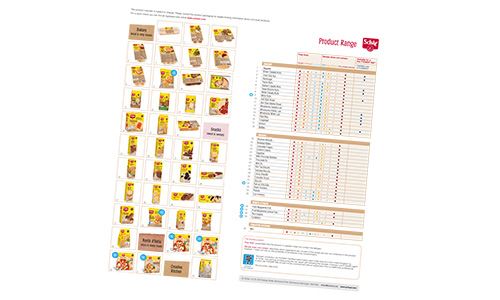Benefits of a gluten-free diet

For the management of coeliac disease, a strict gluten-free diet is associated with resolution of symptoms and a return to health. However, a strict gluten-free diet requires diligence and avoidance of even traces of gluten.
Following diagnosis and the initiation of a strict gluten-free diet, the first positive effects may be visible after just a few weeks. Symptoms, resolve, general health improves and weight loss may be recovered [1]. Serological tests normalize, the small intestine mucous membrane regenerates and deficiency symptoms can be improved. Most individuals who maintain a strict gluten-free diet can live symptom-free [1,2]. A strict gluten-free diet reduces the risk of long-term health problems and complications associated with coeliac disease.
Benefits of a gluten-free diet
- Antibody values normalize
- Small intestine mucosa regenerates
- Risk of consequential damage decreases
- Nutrients are absorbed and utilised by the body again
- Weight loss is normalized
- Health and physical condition improves
- Overall health is improved
- Quality of life improves
- Normalization of growth and developmental patterns in children and adolescents
References
- Rostrom A, Murrary JA, Kagnoff MF. American Gastroenterology Association (AGA) Institute technical review on the diagnosis and management of celiac disease. Gastroenterology 2006; 131: 1981-2002.
- Green PH, Cellier, C. Celiac disease. N Engl J Med 2007; 357: 1731-43
Further information on this topic
Download
2
Show all
Studies
3
Show all

Schar Pocket Sized Product Guide
A complete list of our Schär gluten free retail range, including allergen information, low FODMAP suitability and retailer listings.

Glutafin - Key Product Information and Ordering Codes
A comprehensive list of Glutafin products with their specific ordering codes, units per case, pack sizes, whether they are gluten free or gluten & wheat free, and key nutritional information.

Schar Pocket Sized Product Guide
A complete list of our Schär gluten free retail range, including aller...

Glutafin - Key Product Information and Ordering Codes
A comprehensive list of Glutafin products with their specific ordering...

Long- term response to gluten-free diet as evidence for non-celiac wheat sensitivity in one third of patients with diarrhoea- dominant and mixed-type irritable bowel syndrome
The aim of the study was to analyse if HLA-DQ2 and DQ8 are suitable markers for the diagnosis of wheat sensitivity (WS) and to evaluate the long-term clinical response to a GFD in a defined cohort of patients with IBS-D and IBS-M.
>>Read more<<
>>Read more<<

New NICE Quality Standard on Coeliac Disease supports the provision of gluten-free food on prescription
The National Institute of Health and Care Excellence (NICE) has launched its first Quality Standard on coeliac disease, aiming to drive measurable improvements in the diagnosis, support and health of people with coeliac disease. It also identifies the need to address health inequalities.
>>Read more<<
>>Read more<<

Glycaemic index of some commercial gluten-free foods
ABSTRACT
Purpose
Gluten-free products present major challenges for the food industry in terms of organoleptic, technological and nutritional characteristics. The absence of gluten has been shown to affect starch digestibility, thus increasing the postprandial glycaemic response. However, in recent years, gluten-free technologies have been improved, thus possibly modifying this quality parameter. We investigated the glycaemic index (GI) of 10 commercial foods aiming to update the GI values of the most common gluten-free products consumed in Italy.
Methods
The in vivo GI was evaluated for six bakery products and four types of pasta. The postprandial glucose response was obtained in two groups with 10 healthy volunteers each.
Results
The overall GI values ranged from 37.5 for breakfast biscuits to 66.7 for puffed multigrain cake. Breads and pasta had GI values consistently lower than those previously reported in the literature.
Conclusion
The present study showed that several commercial GF products exhibited low and medium GI values, not confirming the previous observations on the high GI of GF. However, considering the multiple formulations and processes for preparation of these products, further studies are recommended.
Resource: Eur J Nutr. 2014 Oct 17.
Francesca Scazzina • Margherita Dall’Asta • Nicoletta Pellegrini • Furio Brighenti
Purpose
Gluten-free products present major challenges for the food industry in terms of organoleptic, technological and nutritional characteristics. The absence of gluten has been shown to affect starch digestibility, thus increasing the postprandial glycaemic response. However, in recent years, gluten-free technologies have been improved, thus possibly modifying this quality parameter. We investigated the glycaemic index (GI) of 10 commercial foods aiming to update the GI values of the most common gluten-free products consumed in Italy.
Methods
The in vivo GI was evaluated for six bakery products and four types of pasta. The postprandial glucose response was obtained in two groups with 10 healthy volunteers each.
Results
The overall GI values ranged from 37.5 for breakfast biscuits to 66.7 for puffed multigrain cake. Breads and pasta had GI values consistently lower than those previously reported in the literature.
Conclusion
The present study showed that several commercial GF products exhibited low and medium GI values, not confirming the previous observations on the high GI of GF. However, considering the multiple formulations and processes for preparation of these products, further studies are recommended.
Resource: Eur J Nutr. 2014 Oct 17.
Francesca Scazzina • Margherita Dall’Asta • Nicoletta Pellegrini • Furio Brighenti

Long- term response to gluten-free diet as evidence for non-celiac wheat sensitivity in one third of patients with diarrhoea- dominant and mixed-type irritable bowel syndrome
The aim of the study was to analyse if HLA-DQ2 and DQ8 are suitable ma...

New NICE Quality Standard on Coeliac Disease supports the provision of gluten-free food on prescription
The National Institute of Health and Care Excellence (NICE) has launch...

Glycaemic index of some commercial gluten-free foods
ABSTRACT
Purpose
Gluten-free products present major challenges for...
www.drschaer-institute.com
